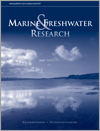Anthony Chariton

Marine and Freshwater Research
Volume 74 Number 5 2023
Special IssueEnvironmental DNA
Anthony Chariton
MF23045Environmental (e)DNA in the aquatic sciences: the CATG is now well and truly out of the bag
MF22045Microbial co-occurrence networks as a biomonitoring tool for aquatic environments: a review
Anthropogenic activities not only alter community composition, but also the ways species interact. This is particularly pertinent in the case of aquatic bacteria, where key processes and functions (e.g. nutrient cycling) are performed as a consortium of interacting taxa. An increasingly common approach for examining and visualising the intra-interactions within complex biological communities is by co-occurrence networks. In this review, we provide an overview of bacterial co-occurrence networks and their properties and propose how these may be used as a biomonitoring tool for aquatic systems.
MF22045 Abstract | MF22045 Full Text | MF22045PDF (1 MB) Open Access Article
Knowing when and where plants are accessing and using groundwater is a major challenge for water managers. Here we propose a new method, using environmental DNA (eDNA) as an indicator of plant groundwater use. If successful, such an indicator would be highly beneficial to water management and may also improve the conversation of groundwater-dependent ecosystems.
MF21293 Abstract | MF21293 Full Text | MF21293PDF (530 KB) Open Access Article
MF20288Development of a 16S metabarcoding assay for the environmental DNA (eDNA) detection of aquatic reptiles across northern Australia
 , Matthew Heydenrych
, Matthew Heydenrych  , Rose Lines
, Rose Lines  , Tony Tucker
, Tony Tucker  , Sabrina Fossette
, Sabrina Fossette  , Scott Whiting and Michael Bunce
, Scott Whiting and Michael Bunce 
Environmental DNA (eDNA) technologies offer a new genetic approach for the non-invasive detection of reptile species in the environment. Here, we develop a mitochondrial 16S rRNA metabarcoding assay, capable of detecting multiple aquatic and semi-aquatic reptile species from environmental samples. This assay successfully detected marine and freshwater turtles, aquatic, semi-aquatic and terrestrial snakes, and terrestrial skinks at two northern Australian locations.
MF20333Environmental DNA as a non-invasive alternative for surveying aquatic communities in tank bromeliads
 , Marcus Thadeu T. Santos, Délio Baêta, Ariadne Fares Sabbag and Célio Fernando Baptista Haddad
, Marcus Thadeu T. Santos, Délio Baêta, Ariadne Fares Sabbag and Célio Fernando Baptista Haddad
Tank bromeliads are crucial for survival of several species. We searched for DNA traces of three potentially threatened amphibians in the water accumulated in bromeliads in Brazil. Our results showed that more amphibian species can eventually use bromeliads as shelter than was previously thought, evidencing the importance for investigations about interactions and conservation status of amphibians and bromeliads.
Sediment DNA-based approaches for monitoring benthic biota are democratising but their large-scale implementation remains limited by the use of expensive and time-consuming commercial DNA extraction kits. We assessed the reliability of a quick and cheap extracellular DNA extraction method for characterising sediment communities for biomonitoring purposes. This approach provides consistent biodiversity patterns, making it a promising alternative for the ecological assessment of aquatic environments.
MF20269 Abstract | MF20269 Full Text | MF20269PDF (1.4 MB) | MF20269Supplementary Material (1.6 MB) Open Access Article



